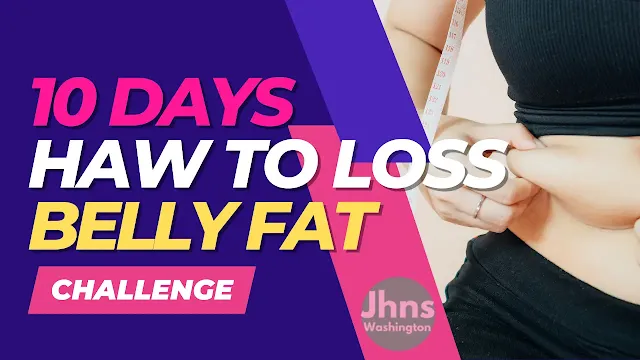Belly fat is not only, but also unhealthy. It can increase the risk of various diseases, such as diabetes, heart disease, and some cancers. Losing belly fat can be challenging, especially if you have a busy lifestyle and a lot of stress. But it is not impossible. With simple changes in your diet and exercise routine, you can achieve noticeable results in 10 days. This article will show you how to lose belly fat in 10 days and give you some tips and tricks to maintain your progress.
Understanding Belly Fat
Before diving into the how-tos, it's crucial to understand what belly fat is and why it's harmful. Belly fat, also known as visceral fat, is the fat stored around your abdominal organs. It's more than just a nuisance that makes your clothes feel tight; it's harmful. This type of fat is linked to various health issues, making its reduction not only a matter of appearance but also of health.
Why Is Belly Fat Harmful?
Visceral fat is metabolically active and can significantly affect your body's functions. It releases inflammatory markers and hormones that can lead to insulin resistance, type 2 diabetes, heart disease, and other conditions. Thus, losing belly fat is about looking good and ensuring your body runs optimally.
What causes belly fat?
Before we dive into the methods of losing belly fat, let us first understand what causes it. Belly fat, also known as visceral fat, is the fat that accumulates around your internal organs, such as your liver, pancreas, and intestines. Several factors contribute to belly fat, such as:
- Genetics: Some people are more prone to store fat in their abdomen than others due to their genes. This can also affect how easily they lose or gain weight.
- Age: As we age, our metabolism slows down, and our muscle mass decreases. This means we burn fewer calories, and more are stored as fat. Moreover, hormonal changes, such as menopause in women, can also affect fat distribution and storage.
- Diet: Eating too many calories, especially from processed foods, refined sugars, and unhealthy fats, can lead to weight gain and belly fat. These foods also cause inflammation, which can worsen the problem. On the other hand, eating too few calories can also backfire, lowering your metabolism and making your body hold on to fat.
- Lack of exercise: Physical activity is essential for burning calories and toning your muscles. Sedentary people are more likely to accumulate fat in their belly and other body parts. Exercise also helps regulate your blood sugar levels, which can prevent insulin resistance and diabetes, which are linked to belly fat.
- Stress: Stress can trigger the release of cortisol, a hormone that increases your appetite and makes you crave sugary and fatty foods. Cortisol also promotes fat storage in your abdomen, as it interferes with the action of insulin. Moreover, stress can disrupt your sleep quality and affect your metabolism and hormones.
How to lose belly fat in 10 days?
Now that you know the causes of belly fat let us see how you can lose it in 10 days. Of course, you cannot expect to lose all of your belly fat quickly, but you can certainly make a significant difference.
Here are some steps you can follow to achieve your goal:
Step 1: Cut down on calories
The first and most important step to lose belly fat is to create a calorie deficit, meaning you consume fewer calories than you burn. This will force your body to use its fat stores as an energy source and reduce belly fat.
However, it would be best not to go too low on calories, as this can harm your health and metabolism.
A safe and effective calorie deficit is around 500 calories per day, which can help you lose about 0.5 kg (1 pound) of fat per week. You can eat less, exercise more, or do both to create this deficit.
To eat less, you should focus on eating more nutrient-dense foods, such as fruits, vegetables, lean proteins, whole grains, nuts, seeds, and healthy fats.
These foods will fill you up, provide you with essential vitamins and minerals, and keep your blood sugar levels stable. Avoiding or limiting foods high in calories but low in nutrients, such as processed foods, refined sugars, and unhealthy fats, would be best.
These foods will spike your blood sugar levels, increase your inflammation, and make you hungry again soon. It would help if you also drank plenty of water, as it can help you feel full and flush out toxins from your body.
To exercise more, you should aim for at least 150 minutes of moderate-intensity aerobic exercise per week, such as brisk walking, jogging, cycling, swimming, or dancing.
Aerobic exercise will help burn calories, improve cardiovascular health, and reduce stress levels. You should also include high-intensity interval training (HIIT) in your routine, which involves alternating between short bursts of intense exercise and more extended rest periods.
HIIT will help you burn more calories in less time, boost your metabolism, and increase your fat-burning hormones. You can do HIIT with any exercise, such as running, jumping, skipping, or burpees. A typical HIIT session can last from 10 to 30 minutes, and you can do it two to three times per week.
Step 2: Increase your protein intake
Protein is an essential macronutrient for losing belly fat, as it has several benefits, such as:
It helps you build and maintain your muscle mass, which can increase your metabolism and calorie-burning potential.
It enables you to feel full and satisfied, which can reduce your appetite and calorie intake.
It enables you to regulate your blood sugar levels, which can prevent insulin resistance and diabetes, which are linked to belly fat.
It helps you stimulate your fat-burning hormones, such as glucagon and growth hormone, which can break down your fat stores.
Aim for at least 0.8 grams per kilogram of body weight per day or about 20 to 30 percent of your total calories to increase your protein intake.
For example, if you weigh 70 kg (154 pounds), you should eat at least 56 grams of protein per day, or about 224 to 336 calories from protein.
You can get protein from various sources, such as eggs, chicken, turkey, fish, tofu, beans, lentils, quinoa, yogurt, cheese, nuts, seeds, and protein shakes.
It would be best to try to eat protein with every meal and snack, especially after your workouts, as this can help you repair your muscles and recover faster.
Step 3: Add more fiber to your diet
Fiber is another essential nutrient for losing belly fat, as it has several benefits, such as:
It helps you feel full and satisfied, which can reduce your appetite and calorie intake.
It helps you improve your digestion and bowel movements, which can prevent constipation and bloating, making your belly look more prominent.
It helps you lower your cholesterol and blood pressure levels, which can reduce your risk of heart disease and stroke, both of which are linked to belly fat.
It helps you feed your beneficial gut bacteria, which can improve your immune system, mood, and metabolism and prevent inflammation and obesity.
To add more fiber to your diet, aim for at least 25 to 30 grams per day or 10 to 15 grams per 1000 calories. You can get your fiber from various sources, such as fruits, vegetables, whole grains, nuts, seeds, and legumes.
You should eat multiple fiber-rich foods and include soluble and insoluble fiber in your diet. Soluble fiber dissolves in water and forms a gel-like substance in your stomach, slowing down digestion and sugar and fat absorption.
Insoluble fiber does not dissolve in water and adds bulk to your stool, speeding up your transit time and preventing constipation. Some examples of soluble fiber are oats, apples, oranges, berries, beans, lentils, and psyllium husk. Some examples of insoluble fiber are wheat bran, corn, carrots, broccoli, and nuts.
Step 4: Reduce your stress levels
Stress is one of the major enemies of losing belly fat, as it can sabotage your efforts in many ways, such as:
It can increase your cortisol levels, increase your appetite, and make you crave sugary and fatty foods. Cortisol also promotes fat storage in your abdomen, as it interferes with the action of insulin.
It can disrupt your sleep quality, affecting your metabolism and hormones. Lack of sleep can lower your leptin levels, the hormone that signals your brain that you are full. It can also raise your ghrelin levels, which is the hormone that stimulates your hunger. This can make you eat more and burn less calories.
It can lower your motivation and willpower, making you skip workouts and cheat on your diet. It can also make you more prone to emotional eating, which is using food as a coping mechanism for your negative feelings.
To reduce your stress levels, you should identify and eliminate the sources of stress in your life, such as work, family, or personal issues. It would help if you also practice relaxation techniques like meditation, yoga, breathing exercises, or massage.
These techniques can help you calm your mind and body and lower your cortisol levels. You should also find some healthy outlets for your stress, such as hobbies, sports, music, or art. These activities can help you distract yourself from your problems and release some endorphins, the hormones that make you feel happy and relaxed.
You should also seek social support like friends, family, or a therapist. These people can help you vent your feelings, offer advice, or listen to you.
Step 5: Drink more green tea
Green tea is one of the best beverages for losing belly fat, as it has several benefits, such as:
It contains caffeine, which can boost your metabolism and energy levels and help you burn more calories.
It contains catechins, antioxidants that can enhance your fat-burning enzymes and reduce fat absorption.
It contains theanine, an amino acid that can reduce stress levels and improve mood.
To drink more green tea, you should aim for at least three to four cups daily, preferably before or after your meals. You should also brew your green tea with fresh and hot water and steep it for about three to five minutes to extract its optimal benefits.
You should avoid adding sugar, milk, or cream to your green tea, as these can negate its effects. You can add some lemon, honey, or mint to enhance its flavor and health benefits.
Conclusion
Losing belly fat in 10 days is not a miracle but a realistic and achievable goal. Following the steps outlined above, you can create a calorie deficit, increase your protein and fiber intake, reduce your stress levels, and drink more green tea. These steps will help you burn more calories, improve your metabolism and hormones, and reduce inflammation and bloating. You will also feel more energetic, confident, and happy.
However, it would be best if you did not stop there. You should continue to follow these steps beyond the 10 days and make them a part of your lifestyle. This way, you can maintain your progress and prevent your belly fat from returning.
Remember, losing belly fat is suitable not only for your appearance but also for your health and well-being. So, what are you waiting for? Start today, and see the difference in 10 days!

